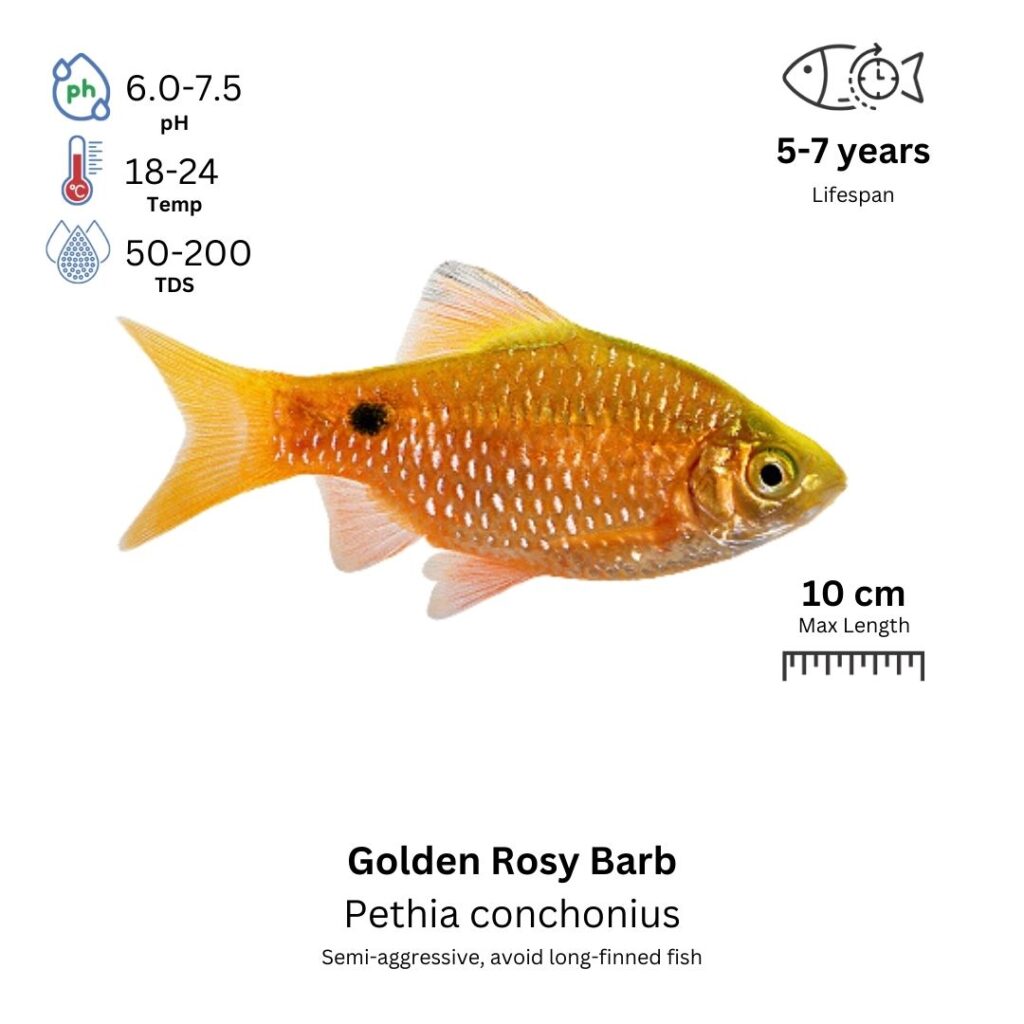Golden Rosy Barb
Puntius conchonius

Description
The Golden Rosy Barb is a brightly colored variant of the popular Rosy Barb, known for its stunning golden-yellow coloration. The body of the Golden Rosy Barb is a vibrant golden yellow, and its fins have a reddish tint, giving it a warm, attractive appearance. The males are typically smaller and more colorful than females, especially when displaying during breeding periods. Females are slightly larger and have a more subdued coloration. Golden Rosy Barbs are active, peaceful fish that do well in schools. They are lively swimmers, and their bold colors make them a visually striking addition to a community aquarium. They are hardy and relatively easy to care for, making them a popular choice for both beginners and experienced hobbyists.
Habitat Origin
Native to the freshwater rivers and streams of South Asia, particularly in India and Bangladesh. Rosy Barbs are typically found in slow-moving waters with moderate flow, where they thrive in slightly acidic to neutral water conditions. The Golden Rosy Barb is a selectively bred variant of the wild Rosy Barb, and it shares similar habitat preferences, including areas with dense vegetation and submerged rocks.
Aquarium
Ideal Number in Aquarium: At least 6 individuals, as they are schooling fish and feel more secure in groups.
Favorite Food:

Golden Rosy Barbs are omnivores and will accept a variety of foods. They can be fed high-quality flake food, micro pellets, and live or frozen foods such as brine shrimp, daphnia, and bloodworms. They will also graze on algae and plant matter, making them ideal for planted tanks. A varied diet ensures they remain healthy and vibrant.
Behavior:
Golden Rosy Barbs are peaceful, active fish that thrive in groups. They are lively swimmers and are often seen darting through the middle or upper regions of the tank. These fish are not aggressive and do well in community aquariums with other small, non-aggressive species. They are social and enjoy the company of other barbs or peaceful fish, and they are especially active during feeding times. While they are generally calm, they can become a bit territorial during breeding periods, but this behavior is usually not a concern in community tanks with proper space.
Special Care:
Golden Rosy Barbs are relatively hardy but prefer stable water conditions. They thrive in slightly acidic to neutral water and should be kept in a tank with good filtration and regular water changes. They are adaptable to a wide range of water conditions, but they do best in environments that replicate their natural habitat with moderate water flow. It’s important to provide them with plenty of swimming space and some plants or decorations for hiding spots.
Compatibility with Other Fish:
Yes, Golden Rosy Barbs are compatible with other peaceful species, especially those that are small to medium in size. They do well with other barbs, tetras, rasboras, and small catfish. However, it is best to avoid keeping them with larger, more aggressive species that might stress or bully them. Golden Rosy Barbs are particularly suited for community tanks with other non-aggressive fish.
Breeding Setup
Setting up a separate breeding tank is highly recommended for Golden Rosy Barbs. A 40-liter (10-gallon) tank gives sufficient space for courtship and spawning while enabling better control of water quality. Ideal water parameters include a pH of 6.5–7.5, temperature between 24–28°C (75–82°F), and GH of 4–12 dGH. Use a gentle sponge filter to maintain calm water and protect delicate eggs. For the substrate, use fine gravel or sand, and add live plants like Java moss or Hornwort for egg attachment and fry cover. Include floating plants to mimic their natural low-light habitat. Keep lighting moderate to avoid stress.
Conditioning for Breeding
To condition Golden Rosy Barbs, provide a protein-rich and varied diet. Feed them live foods such as daphnia, brine shrimp, and bloodworms, along with high-quality flakes or frozen foods. This enhances their coloration and prepares females for egg production. Ensure water is clean and stable by performing weekly water changes of around 25%. Clean water encourages natural spawning behavior and overall fish health.
Spawning Process
Golden Rosy Barbs are egg scatterers, usually spawning in the early morning or during dim lighting in the evening. Males display their bright colors and chase the females during courtship. A single female may lay 100–200 sticky eggs, which will adhere to plants, tank walls, or other surfaces. Immediately remove adult fish after spawning, as they may eat the eggs. Separation is crucial for ensuring a high hatch rate.
Fry Care
Eggs hatch in approximately 24–36 hours, depending on temperature. Newly hatched fry will cling to surfaces and absorb nutrients from their yolk sacs before becoming free-swimming. At that stage, feed them infusoria, liquid fry food, or microscopic live foods such as rotifers. After a few days, introduce baby brine shrimp and crushed high-quality flakes. Perform daily water changes of 10–15%, maintain a stable 24–28°C temperature, and closely monitor water quality to ensure safe ammonia and nitrite levels.
Important Notes
Golden Rosy Barbs become sexually mature around 6–12 months. Males are slimmer and more colorful, especially during breeding, while females appear larger and rounder when carrying eggs. To maximize breeding success, maintain stable water parameters, avoid tank overcrowding, and ensure a peaceful tank environment free from aggression. Proper preparation and care during and after spawning will lead to healthier fry and better survival rates.
